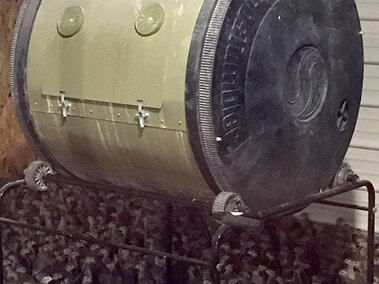PILOT STUDY: IN-HOUSE COMPOSTING
A pilot study was conducted to evaluate in-house poultry mortality composting in a game bird operation. For this study, a commercially available tumbler composter (Mantis Co., Southampton, PA) was placed in a brooder building (Figure 1). This unit was selected because it was relatively inexpensive (under $500), simple to operate, and was not expected to negatively impact bird health or movement. The metal frame upon which it is mounted prevents birds from accessing the contents of the composter and does not occupy floor space or restrict bird movement.
The material composted contained litter (bedding and manure mixure from the floor of the production house), disposable feed trays, and bird carcasses (Figure 2). The producer rotated the drum daily to aerate the mixture and added carcasses, litter, and water as needed to maintain the target carbon-to-nitrogen ratio and moisture. At the completion of the production cycle, the contents of the drum were removed and the unit was cleaned and disinfected with the rest of the building. The unit has remained in the facility through several subsequent production cycles, each lasting about five weeks, with the same operational protocol being utilized.
Assessment of the practice is currently based upon direct feedback from the producer as no measures of pathogen prevalence in the compost mixture, temperature during composting, or quality of finished compost are being conducted due to funding limitations. The producer has reported, thus far, that:
- The unit is convenient since it allows for the disposal of dead birds during daily “choring.”
- No odors have been detected from the unit other than when the door is opened to add contents.
- Operation of the handle to rotate the drum and aerate the contents is simple to perform.
- No insects or other pests associated with the compost have been noted.
- No increase in disease has been attributed to the presence of the composter inside the building.

Figure 1. A composter located in brooder facility with birds surrounding the base of the unit.

Figure 2. The contents of a composter.